![]()

![]()
![]()
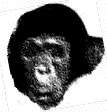


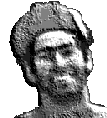
"Robert Tomarchin, a
27-year-old U.S. citizen and his pet ape Moko" - in 1957 .
Photos courtesy of Dr. Herbert Ford , of the Pitcairn
Islands Study Center at Pacific Union College.
Henderson Island is an uninhabited raised reef island, which is the largest island in the Pitcairn Island group. It is 9.6 km long by 5.1 km wide with an area of 36 square km.
Henderson Island was the site of a modern castaway story in 1957 - one of the marooned seamen was a chimpanzee!
The Henderson Island Monkey Story
The Participants

![]() In
the late 1940's, John Owen Wells, a schoolteacher in Vancouver,
Canada began building a 38' 13-ton auxiliary ketch which he later
called the Flying Walrus. After five years he completed
the yacht. It was painted blue and white and had an auxiliary
engine and was equipped with a radio receiver.
In
the late 1940's, John Owen Wells, a schoolteacher in Vancouver,
Canada began building a 38' 13-ton auxiliary ketch which he later
called the Flying Walrus. After five years he completed
the yacht. It was painted blue and white and had an auxiliary
engine and was equipped with a radio receiver.
With his wife Diane, a school gym instructor and physiotherapist, he began a Pacific voyage with the goal of reaching Auckland, New Zealand. Here the Wells couple intended to stay for approximately 1-½ years. After this prolonged stay in Auckland they planned to continue their cruise around the world.
People who had met Wells and his wife in San Francisco and Tahiti described them as a very level-headed couple. Wells was reported as being quiet and reserved, with a keen knowledge of sailing. He was described as a very nice guy. One person who had met them in Tahiti reported that they were honeymooning. Wells told this person that he was thinking of "giving away" school teaching and working as a boatbuilder in Auckland.
They were a very nice couple, friendly and interesting to talk to. Their boat was new when they left Canada and was in excellent condition when we saw it in Tahiti. It is unlikely they would get lost or become shipwrecked. They were both very experienced in handling boats.
Mrs. Wells was described as having delicate features and a very good personality.
You wouldn't describe her as attractive, but she had a very pleasing manner. She told us she intended to continue her job as a gym instructor when she reached New Zealand.
Three years after leaving Vancouver they met Robert Tomarchin, from Florida USA, in Papeete, Tahiti.
Some of Robert Tomarchin’s movements in the 18 months prior to meeting the Wells family in Tahiti are known. Little else is known about Tomarchin.
Tomarchin was in Suva, the Fiji Islands, on two occasions. On the first occasion, Tomarchin caught an aircraft to Tahiti. Tomarchin booked his passage to Tahiti but did not have either sea or air tickets for getting out of Tahiti. Questioned about this by airline officials Tomarchin showed them a large amount of money in travellers' cheques. On the second occasion he was on his way back from Tahiti after the authorities there had ordered his deportation. After about three months in Tahiti, Tomarchin apparently ran out of money and the authorities in Tahiti ordered the airline to carry him back to Fiji free of charge. From Fiji, another airline took him back to Hawaii.
Tomarchin was next heard of in Apia about two months prior to meeting the Wells couple on Tahiti. He arrived with a chimpanzee. His documents were all in order, as were the multitude of documents needed for the chimpanzee. Tomarchin on this occasion too, appeared to have plenty of money in travellers' cheques. The airline took him to Tahiti where his intentions were apparently, to exhibit the chimpanzee at the Bastille Day (14 July) celebrations in Papeete.
A passenger on the same TEAL flying-boat in which Robert Tomarchin flew from Apia (Samoa) to Papeete (Tahiti) reported that the 9 lb chimpanzee was on the aircraft dining table in front of Tomarchin in a portable cage 1 ft high. The passenger also said that Tomarchin, a seemingly well-educated American in his late twenties, did not say where he found the animal or what his purpose was in carrying it about the Pacific.
The chimp Moko was just under 12 months old. Tomarchin claimed that Moko was the only pure white-skinned chimpanzee in the United States. Even around Moko's eyes was not to be found the normal dark band found in other chimps. Tomarchin said that Moko had been born on an experimental farm in East Africa, but even before his birth Tomarchin had the option to purchase him. Tomarchin claimed that Moko’s arrival by air in Miami, Florida, as a four-pound bundle, had caused quite a stir with reporters and photographers vying for a position from which to take a shot.
The Tahiti authorities, it is believed, refused to allow Tomarchin to exhibit the chimpanzee during the Bastille Day celebrations in Papeete
Tomarchin's profession, if any, is not known. Where the money he had to pay for his travels came from is not known.
Tomarchin met John and Diane Wells in Papeete. He, and Moko, were onboard the Flying Walrus when it left Papeete on July 18, four days after the Bastille Day celebrations, officially bound for Mangareva, Pitcairn, Raivavae, Tubuai and Auckland.
Part 1: The Pitcairn Visit of the Flying Walrus
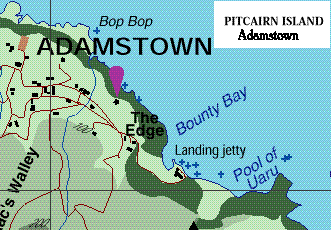
![]() On
the Sabbath morning of August 10, 1957 Morris Warren rang the
bell five short times and the Pitcairn Islanders ran to The Edge.
They saw the Canadian yacht Flying Walrus anchor off
Bounty Bay. One of the island's longboats was launched and went
out to meet the yacht. The islanders learned that a Canadian
couple, John Owen Wells and Diane Wells were on board. The Flying
Walrus, they said, had taken ten days to make the three-day
trip from Mangareva, due to a storm. The Flying Walrus had
coconuts and mail from Mangareva to deliver to the Pitcairn
Islanders
On
the Sabbath morning of August 10, 1957 Morris Warren rang the
bell five short times and the Pitcairn Islanders ran to The Edge.
They saw the Canadian yacht Flying Walrus anchor off
Bounty Bay. One of the island's longboats was launched and went
out to meet the yacht. The islanders learned that a Canadian
couple, John Owen Wells and Diane Wells were on board. The Flying
Walrus, they said, had taken ten days to make the three-day
trip from Mangareva, due to a storm. The Flying Walrus had
coconuts and mail from Mangareva to deliver to the Pitcairn
Islanders
Diane Wells came ashore and spent the day on the island.
Roy Clark later told the Danish author Arne Falk-Rønne that Diane Wells told the islanders that she was pregnant and that she and her husband were in a big rush to get to New Zealand. The islanders asked how she and her husband were able to manage sailing their yacht alone. She told them that: we had a crewman, but he was unreliable, and he left us at one of the islands we visited.
Another report merely tells that Mrs. Wells visited the Sabbath School, and heard a farewell hymn, "In the Sweet By and By," sung for her. She then had a look around the village of Adamstown and returned to her yacht. The Flying Walrus left again that evening for Mangareva.
Part 2: Sighting on Henderson Island
![]() A
month later, on the the 7th of September, the Shaw Savill cargo
liner MS Corinthic, Capt.(Arthur) Jones in command,
arrived at Pitcairn. Parkin Christian got the news first. Captain
Jones of the Corinthic, asked him as soon as he went
aboard if any Pitcairn Island men were on Henderson Island. Corinthic
had passed Henderson on its way from Panama to New Zealand. On
being assured that none were, Capt. Jones notified Parkin that
one of his passengers had observed signals (a sheet or a shirt
being waved) being flashed from the North Beach of the Island.
When binoculars were used, a man wearing shorts and what appeared
to be a child, could be seen running along the sand as if to
attract attention.
A
month later, on the the 7th of September, the Shaw Savill cargo
liner MS Corinthic, Capt.(Arthur) Jones in command,
arrived at Pitcairn. Parkin Christian got the news first. Captain
Jones of the Corinthic, asked him as soon as he went
aboard if any Pitcairn Island men were on Henderson Island. Corinthic
had passed Henderson on its way from Panama to New Zealand. On
being assured that none were, Capt. Jones notified Parkin that
one of his passengers had observed signals (a sheet or a shirt
being waved) being flashed from the North Beach of the Island.
When binoculars were used, a man wearing shorts and what appeared
to be a child, could be seen running along the sand as if to
attract attention.
Captain Jones had assumed that he had seen members of a boat crew from Pitcairn visiting the island. The Pitcairners occasionally visit Henderson Island to cut Miro wood, which is used to make the curios they sell to passing ships Later, however, he gave another explanation in New Zealand of why he did not stop to investigate. He said that he knew that a scientist was doing some research work on Pitcairn Island in connection with the International Geophysical Year and thought that the person he observed was this scientist. Tom Christian confirms that a scientist named Gene Gillis was on Pitcairn. He set up a Tide gauge and oceanographic recording station. The station was then handed over to Floyd McCoy for taking daily readings. He did not visit Henderson as far as I know.
It was a long time since anyone from Pitcairn had been on Henderson Island. They began to think that there might be a connection between the crewman from the Flying Walrus who Mrs. Wells told them had jumped ship on an island, and the figures on Henderson Island that Capt. Jones told them about.
The Pitcairners were worried that these people were unlikely to be able to find any water on the island, and that they would die of thirst if they didn't rush to get them away from the island.
Before evening fell, Tom Christian, Radio Officer, sent a radio message from the Pitcairn Island Radio Station ZBP, to the administration in Fiji, asking for instructions. On behalf of the Governor of Fiji (Sir Ronald Garvey), who was also Governor of the Pitcairn Islands group, a message was flashed to Parkin Christian, the Pitcairn Chief Magistrate, suggesting that the Pitcairners should investigate the matter further. It was ascertained that no ships were near enough to Henderson to investigate. Arrangements were made on Pitcairn to send up 2 longboats with volunteer crews. When an American freighter, the Pioneer Isle, arrived two days later, Tom Christian called the vessel from the Pitcairn Island Radio Station. He made arrangements with the Captain to transport the two longboats and their crews onboard the Pioneer Isle to Henderson Island, in order to discover who the mysterious occupants were.
Sunday morning was all bustle and preparation. The weather was unfavourable, the responsibility of sending a party accordingly very heavy. The Pitcairn Council met to deliberate, and while the Council was in session, Tom Christian received a message from the Pioneer Isle that she would take two boats and their crews to Henderson at 8 a.m. the following day (Sept. 9). And that is how several Pitcairn men had their first trip on an ocean-going boat!
Part 3: Rescue Trip to Henderson Island
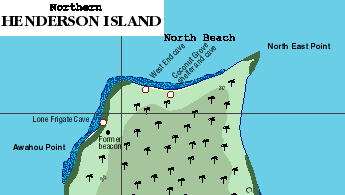
![]() What
a trip! The American sailors and officers of the United States
Lines vessel Pioneer Isle were extremely kind, handing out
books and presents of clothing, etc. to the Pitcairn Islanders.
The seven hours' run, filled with exploring the 8,380 tons 439
ft. ship, talking and feeding, seemed to take no time. When the Pioneer
Isle rounded the Northern point of Henderson Island, just
after lunch, a flashing mirror and a white flag on a mast were
observed. There was someone there all right. Now, how were they
going to fit into the speculations of the Pitcairners? Had they
been shipwrecked? Did they have a sick companion?
What
a trip! The American sailors and officers of the United States
Lines vessel Pioneer Isle were extremely kind, handing out
books and presents of clothing, etc. to the Pitcairn Islanders.
The seven hours' run, filled with exploring the 8,380 tons 439
ft. ship, talking and feeding, seemed to take no time. When the Pioneer
Isle rounded the Northern point of Henderson Island, just
after lunch, a flashing mirror and a white flag on a mast were
observed. There was someone there all right. Now, how were they
going to fit into the speculations of the Pitcairners? Had they
been shipwrecked? Did they have a sick companion?
Several men now went ashore in a longboat, led by Floyd McCoy. Floyd was Navigator and Inspector of Police, as well as a world-famous radio `ham.'
A young man came out to meet the longboat. He met them in tears and jumped onboard and hugged Pervis Young. He told him that he was an American and that the Flying Walrus had cast him away. Upon the beach was a baby chimp, and "didn't that make our eyes pop out!"
"You have saved my life!" he told them. "There are thousands of rats, and they have eaten all the supplies I had with me. If you hadn't come here, I and Moko would have died in a short time."
No one was in doubt who Moko was. A chimpanzee ran screaming of joy back and forth on the beach.
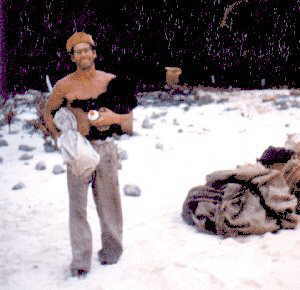
Tomarchin and Moko on Henderson Island Tom Christian wrote: The photo is definitely Robert Tomarchin on the beach at Henderson. Photo courtesy of Dr. Herbert Ford , of the Pitcairn Islands Study Center at Pacific Union College. This photo was supplied by Ron Edwards of Hallam, Victoria, Australia who found it during a routine clean up at the Courthouse at Pitcairn in 1980/1. Thank you Ron for contacting the Henderson Island Website, and donating the photo to Dr. Ford's collection!
The young man told them that his name was Robert Tomarchin and that he was from Florida, USA.
He told the Pitcairners that he had been on his way back home to the USA from the Bastille Celebrations on Tahiti. He had taken a job as a crewman on the Canadian yacht Flying Walrus, with the condition that he could take his chimpanzee Moko with him onboard too.
Unfortunately, it soon turned out that the chimp was too much for the Captain of the Flying Walrus, and especially for his nervous wife, Tomarchin claimed. The last straw was when it ate the wife's vitamins near Henderson.
Tomarchin told the Pitcairners that the Flying Walrus anchored near Henderson and Mr. Wells asked Tomarchin and Moko to stay on the island for a few days "breathing spell" until Mrs. Wells' nerves had relaxed. Tomarchin and Moko were given some supplies and were rowed ashore by Mr. Wells. The next morning Tomarchin looked out to sea and the Flying Walrus was gone. He knew he was alone on the island now, and that he was left to his own fate.
Tomarchin told the islanders: Thousands of rats appeared and attacked my camp - eating most of my supplies. I made a bonfire and that kept them away from the camp. I found some coconuts and some bird's eggs to eat and spent my time looking for ships on the horizon. No ships were to be seen, and I became desperate.
Tomarchin claimed that the Wells family marooned him on the 28th of July, and that he saw his first ship in the middle of August. This may have been the Rangitiki, which arrived at Pitcairn on August 26th. He tried to attract the attention of the ship but he didn't know whether they had seen him. The ship continued on it's course and was soon just a dot on the horizon. Tomarchin's situation was now critical, as he had eaten all the bird's eggs he could find, and all the coconuts that were within easy reach.
Tomarchin claimed that he had never heard of Henderson Island before and that he hadn't consulted any Pilot Manual before leaving the Flying Walrus, and that he didn't know if there was any water on the island.
It was clear to the Pitcairners who picked him up that he was not telling "quite a straight story" about his being a castaway from the Flying Walrus.
When Tomarchin was discovered he was found living in a well-stocked tent. Among his provisions: a sturdy nylon tent, bed, twelve cases of tinned food, radio, case of batteries to power it, gramophone with metal records, candles, torch cells, a rifle w/ 1,000 rounds of ammunition, fishing rods, 80-pound bow with arrows, cross-bow, underwater fishing equipment, rubber raft, rubber canoe, a case of seeds of flowers & vegetables, a case of mixed nails and other supplies. He also had good luggage, plenty of clothes and a book with plenty of travellers’ cheques. He also had some chickens and a 44-gallon drum of water. He also had a large galvanised drum for collecting water and had gone around each morning shaking the dew from leaves and dipping water our of small hollows in tree branches, etc.
All this equipment was quite a lot for a small yacht the size of the 38 foot Flying Walrus to leave behind.
Tomarchin had raised a mast about 30 feet high that might have been a mast from a ketch or small boat. Evidently he used this as signal halyard, as a flag was pulled up and down--a white flag about five feet by eight feet. Parkin Christian, the Pitcairn Chief Magistrate, later commented that he could never have found that flag pole on the island. Later speculation suggested that this might have been the flagpole erected by H.M.S. Leander in 1937. Tom Christian recently asked Clary Young and Len Brown, who were both on Pitcairn and in the rescue party to Henderson, about this and they think it had just been lying on the Island and was found and re-erected by Bob Tomarchin.
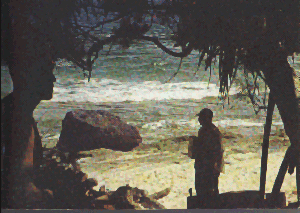
Pitcairn Islanders visit Henderson Island
A passenger on the Pioneer Isle said he thought he made out a beach umbrella on the beach. Tomarchin was wearing clothes somewhat like Robinson Crusoe--scalloped trousers and a funny-cut cap. The Captain of the Pioneer Isle reported that Tomarchin had apparently shaved very recently and that he did not want anything from the ship's stores, nor did he want anyone notified.
Tomarchin later told Tom Christian that he was under the impression that the Pitcairners went to Henderson frequently for wood but after arriving he saw evidence that they had not been there for some time. The Pitcairners have always landed on the North or the West beach to cut Miro wood, but it had been quite some time since the last visit. The North beach is preferred, since it is approximately 2 miles long, and there is much more wood both Miro, and Tau. Landing on any of the beaches (North, East or West) can be difficult if there is a large surf on the reefs. The Pitcairners set up camp on the shore and begin cutting the Miro wood they need for the carvings they sell to those on passing ships.
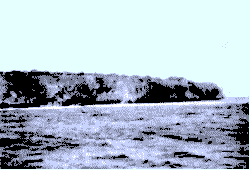
30m. high coastal headland at the Western end of North Beach
There is a certain place on "their" side of the island where, just at the waterline, a spring of slightly brackish water runs into the ocean. In an emergency it can be used to sustain life. However, from the North Beach it is virtually impossible to get to this marginal water source without going around the island by water. Tomarchin tried to cut his way through to the opposite side of the island, but the Pitcairners who came to get him said they couldn't follow his trail, with the clear implication that it did not penetrate through to the opposite site. There is very, very heavy growth and bad coral everywhere.
Part 4: Return to Pitcairn

![]() The
Captain of the Pioneer Isle was willing to take Tomarchin
with him to Panama, but not Moko. Bob refused to be separated
from Moko. The Pitcairn Islanders took pity on the young man and
allowed him and Moko to come back with them to their island in
their longboats. That meant going back to the beach, camping the
night, and leaving the next day for home, after taking the
opportunity to gather Miro wood. The 115-mile run back to
Pitcairn in the longboats took 23 hours, the weather had been
fair but uncertain at times.
The
Captain of the Pioneer Isle was willing to take Tomarchin
with him to Panama, but not Moko. Bob refused to be separated
from Moko. The Pitcairn Islanders took pity on the young man and
allowed him and Moko to come back with them to their island in
their longboats. That meant going back to the beach, camping the
night, and leaving the next day for home, after taking the
opportunity to gather Miro wood. The 115-mile run back to
Pitcairn in the longboats took 23 hours, the weather had been
fair but uncertain at times.
On September 10th, the very same day the Pitcairners were on Henderson Island to "rescue" Tomarchin, the Flying Walrus radioed to Tom Christian at the Pitcairn Island Radio Station that Tomarchin had paid them to be put ashore on Henderson Island.
The families on Pitcairn were watching the weather just as anxiously as their loved ones on Henderson. The wind had swung around until it blew directly from Pitcairn towards Henderson and had remained there for several days. However, on Henderson, they noticed that the wind was slowly shifting further to the west, so they set sail (with Bob and Moko). The quartering wind remained favourable for the entire 115-mile voyage on a direct course to Pitcairn. The families on Pitcairn were surprised to see the boats coming in on a direct course, as the wind had never varied from directly Southwest. There had been no sign of any change, right up to the time the boats entered the harbour, heading, from their point of view, straight into the headwind. They were convinced that only the hand of the Lord, whom `even the winds and the waves obey...' had controlled the elements in their miraculous voyage.
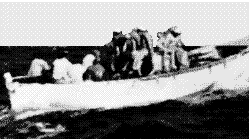
A Pitcairn longboat at sea
Part 5: Tomarchin and Moko on Pitcairn

![]() Moko's
arrival on Pitcairn was quite an event! At the Landing every eye
was on Bob and his companion. Interested children and grown-ups
soon surrounded them. Then, while the rest of the world wondered
on the mystery of Bob, Moko, Henderson Island and the Flying
Walrus, Pitcairn Island settled down to welcoming its guests.
Bob and his chimp stayed with the Chief Magistrate, Parkin
Christian.
Moko's
arrival on Pitcairn was quite an event! At the Landing every eye
was on Bob and his companion. Interested children and grown-ups
soon surrounded them. Then, while the rest of the world wondered
on the mystery of Bob, Moko, Henderson Island and the Flying
Walrus, Pitcairn Island settled down to welcoming its guests.
Bob and his chimp stayed with the Chief Magistrate, Parkin
Christian.
After a short time Bob Tomarchin was no longer welcome on Pitcairn, at least by those of more mature years.
Bob was a stranger, a very muscular and personable young man of 27 who had come dramatically onto the island. No wonder the girls who had only seen their relatives all their lives should be attracted to Bob, even though he didn't do a tap of work all the time he resided on the island. The elders of the island could see that Bob was of a different character from the Pitcairn Islanders. He just did not fit with the ways of Pitcairn.
It appears that The Governor in Fiji also sensed this problem, as a directive arrived from Fiji instructing that Tomarchin must leave by the next vessel passing Pitcairn. If arrangements had been made by that time for Moko, then, naturally, Moko would go too, but if arrangements were not made then Moko should be destroyed.
The Island Council met. It was a directive, and they were happy in one sense as it relieved them of one problem. The decision would not be theirs. But at the same time they felt for Bob, after all he had done for Moko. So a compromise was arranged. Tomarchin must abide by the directive to leave the island by the next vessel. But Moko could stay on the island for a further period. Bob would be granted 3 months in America during which time he could make arrangements for Moko's medical clearance papers. When these papers arrived, the Pitcairners would immediately send Moko over to him. If, however, he failed to make such arrangements during the 3 months, then Moko became the property of Pitcairn. The islanders could decide his fate, whether to keep him, destroy him, or to sell him to some zoo which was able to arrange the necessary papers.
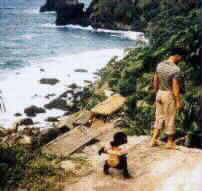
Tomarchin and Moko on Pitcairn Island Pitcairn Island - the White Rocks on the road to the Landing. Photo courtesy of Dr. Herbert Ford , of the Pitcairn Islands Study Center at Pacific Union College.
While Tomarchin was on Pitcairn the Flying Walrus' was contacted. The authorities had begun searching for the Wells', when Tomarchin's story about being marooned on Henderson had become known. At first they could not be located, and fears for their safety were expressed. and a search intitiated. No one knew quite where to begin looking for the vessel. It was known that The Flying Walrus had arrived at Mangareva on August 14 - four days after leaving Pitcairn.
Then one day the Flying Walrus sailed into Rarotonga. Immediately after arriving, they were apprehended and asked to answer questions as to why they had left a man to starve on Henderson. They looked blankly at the interrogator until the import of the question sunk in, then Mr. Wells simply stated, But he paid us $300 to put him there. (Tom Christian recalls that it was $1000.) It now appears that Bob had carefully looked over the map and found that Henderson was a good place from which to stage a publicity stunt. It was large, uninhabited, but was from time to time visited by a well-known people - the descendants of the Mutiny on the HMS Bounty. Further, a shipping route passed by, so it would always be possible to signal a ship if required. The map showed water at a certain point.
John Wells and his wife told the New Zealand Press Association special correspondent at Rarotonga that Robert Tomarchin was left on Henderson Island at his own request. They said that Tomarchin, who was training his pet chimpanzee for television appearances and had supplies for several months, had chartered them to take him to Henderson.
Mr. Wells and his wife said: Tomarchin approached us at Tahiti with a request to take him and his chimpanzee to Henderson which he had visited about two years ago.
The trip was in fact a charter one paid for by Tomarchin who took with him sufficient stores to last several months. Tomarchin's intention was to stay on Henderson until it was visited by Pitcairn Islanders who go to the island about every three months to collect a certain type of timber. When the yacht arrived off Henderson conditions were too rough to land and there was some talk of Tomarchin going on with the yacht to Pitcairn and going back to Henderson later with Pitcairn Islanders. Tomarchin was against this as he was afraid of his chimpanzee contracting an illness at Pitcairn.
Wells said conditions were better on the second day -- August 6 -- and Tomarchin and his stores were landed safely. The Flying Walrus then went to Pitcairn and Mangareva before continuing on to Rarotonga.
A newspaper interviewed a man who had met Wells and his wife on Tahiti.
When we met them they had no one by the name of Robert Tomarchin with them. In fact, they never mentioned picking anyone up in Tahiti or taking on anyone as an extra hand.
Another person interviewed said:
The Wells had no room for a passenger, but they took Mr. Tomarchin and his animal because they were short of money and he offered them a high price in dollars. I did not hear where he was bound or why.He had plenty of dollars
Tom Christian recalls that he heard at the time that Bob had been told that there was treasure on Henderson Island and that he was out in search of it.
When told about the story told by John and Diane Wells on Rarotonga, Bob said that he landed at Henderson Island for a few days rest for myself and my chimpanzee Moko as he had been rather sick during the voyage from Tahiti. He also now claimed that the Flying Walrus had given him a definite assurance that they would return in four days to pick him up. He said that the Wells couple intended returning to Canada via Easter Island and Panama..
Tomarchin's story about the Panama destination of the Wells couple differs from all other reports. In each port of call, John Wells and his wife had told of their intention of sailing to New Zealand via Rarotonga.
An interesting question arises: Had Tomarchin been on Pitcairn and Henderson before? The Wells family reported that he had said he had been on Henderson two years previously. Parkin Christain, the Pitcairn Magistrate, is also reported as telling the master of the Pioneer Isle that Tomarchin had been on Pitcairn at some time in the past. Tom Christian comments that Tomarchin had definitely not visited Pitcairn before, and if he did visit Henderson Island previously it must have been on a visiting yacht. Tom Christian had not heard about Tomarchin trying to find traces of his parents on Henderson and has no information at all on any shipwrecks on or near Henderson at the time indicated by Tomarchin.
Bob and Moko lived on the island from 13th September until 26th October, when the Rangitiki arrived from Wellington, New Zealand, bound for Panama.
Bob was able to arrange passage north on the Rangitiki on October 26. However, as the Captain refused to take Tomarchin's chimp on the vessel, Moko was left in the care of Charles and Charlotte Christian.
A copy of the October 6, 1957 issue of Pitcairn Pilhi (Vol.2, No. 9) has a scrawled, handwritten note at the top of the paper:
![]()
![]()
Betty Christian was in her teens at the time, and remembers that Charles and Charlotte Christian took care of Moko when Tomarchin went back to the States. She remembers that Moko was always dressed like a little baby or boy and that he would hold your hand and walk along with you when you were going somewhere. Also she said that the schoolteacher at the time composed a song about the incident. She does not remember what happened to the song but is pretty sure that no copy exists on Pitcairn now. Another source tells that the song `MOKO,' was forwarded to New Zealand "and may appear on the radio...some day!"
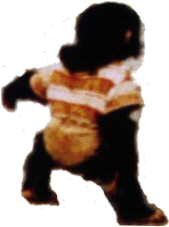
Moko was always dressed like a little baby
Part 6: Pitcairn hadn't seen the last of Bob Tomarchin

![]() Pitcairn
hadn't seen the last of Bob Tomarchin. Little more than a month
later, on November 29, Bob returned to Pitcairn on the Rangitata.
Parkin Christian (the Island magistrate) read a telegram to the
Pitcairners before they left the Landing to visit the Rangitata.
Bob was on board. He had been caught as a stowaway shortly after
the ship left Panama, and, by order of Fiji, the High
Commissioner of the United Kingdom was not to be permitted to
land on Pitcairn.
Pitcairn
hadn't seen the last of Bob Tomarchin. Little more than a month
later, on November 29, Bob returned to Pitcairn on the Rangitata.
Parkin Christian (the Island magistrate) read a telegram to the
Pitcairners before they left the Landing to visit the Rangitata.
Bob was on board. He had been caught as a stowaway shortly after
the ship left Panama, and, by order of Fiji, the High
Commissioner of the United Kingdom was not to be permitted to
land on Pitcairn.
When found as a stowaway in the Rangitata, Tomarchin was locked in the isolation cabin at the stern of the ship. He was put to work painting, and favourably impressed passengers as a likeable man. Then just before the ship reached Pitcairn Island Tomarchin broke free from his cabin as a meal was being served to him. He was found several hours later among the lifeboats and according to passengers became almost berserk. Hoses were turned on him and it took 10 of the crew to subdue him. He was then put back in the isolation cabin and the door made fast with ropes.
The Pitcairners interest in seeing Bob again was intense, but Bob was locked away in the spare hospital room with a guard on watch and no one was allowed to see him or send a message. Charles Christian managed to get fruit to him. As they left the ship Clarence Young yelled out, Goodbye, Bob! And Bob stuck a hand out of the window and waved pathetically.
The Pitcairners knew that some people would say that Bob was foolish. But, Pitcairn Islanders, with the lessons of the Bible before them, could wholeheartedly sympathise with him. In the gracious words of the Pitcairners lovely Lilly (Lilly Warren - Pitcairn's midwife for many years) : We do not know what his reasons are and we should not judge him. He must love Moko more than we realise. All Christians must surely pray that some day soon Moko and his master will be united.
The Rangitata continued on to Auckland with him, and Moko remained on Pitcairn.
In New Zealand, Tomarchin was ordered to pay 98 pounds by a New Zealand magistrate for stowing away on the Rangitata and for a one-way fare and court costs.
The Australian newspaper the Sydney Truth dated 15.12.1957, contains a photo of Robert Tomarchin and Moko, and an interview given to them while he was in New Zealand:
Asked if his mission had been a success, he (Tomarchin) said he would not know until he returned to the U.S. It might be another rags-to-riches story, but I will not know until I get back home, he said. He said he was writing a book on his adventures and life with Moko. The book might explain the Henderson Island enigma, he added.
The same article quotes Tomarchin as saying that he had acquired Moko from a U.S. animal dealer and that Tomarchin regarded Moko as a genius. He responds to commands just to please me.
To the Dominion, an Auckland New Zealand newspaper, he said:
I want to get my chimpanzee back again. I am very attached to Moko. He means everything to me. I don't know what I shall do next, but I shall keep on trying till I get him back.
A report from passengers on the Rangitata that Tomarchin had said he went to Henderson Island to try to find traces of his parents, who were shipwrecked there 20 years ago, was denied. Why did you go to Henderson Island, then? he was asked. I can't tell you that, Tomarchin replied.
This is the first, and only, time we hear about the shipwrecked parents. Was this just tall tales he told the passengers as he had contact with them on shipboard? Just as the story he told Tom Christian about treasure on Henderson Island, it seems Tomarchin often told stories to catch the attention of the people around him. With his beserk behaviour on board the Rangitata, and many of the other things he did, one wonders about Tomarchin's sanity.
The Auckland Herald published a story about him that made a slip or two in factual accuracy. Tomarchin sued them, got 300 pounds, paid off his stowaway debt and made his way back to Pitcairn on the Rangitiki.
The Rangitata and the Rangitiki were both ships of the New Zealand Shipping Company (NZSC), which regularly called at Pitcairn both outbound (from England) and homebound (to England). Captains of all NZSC and Shaw Savill ships were ordered by their companies to call at Pitcairn primarily to give passengers a break during the long Pacific voyage, but also to give the Pitcairners a trading-sales opportunity for their curios.
When the Rangitiki arrived at Pitcairn a few weeks later, Bob was onboard - this time as a paying passenger. Before the ship sailed, Moko was returned to its owner, and the man and his chimpanzee sailed into the sunrise.
It appears that Charles Christian wasn't very concerned about losing the responsibility of caring for Moko. He liked Moko, but not in the way Bob liked him, quite obviously.
Tom Christian recalls that Tomarchin did correspond with someone on Pitcairn for a while but then dropped out of sight.
Part 7: Tomarchin's return to the US

![]() After
Tomarchin's return to the US, Moko was featured on American TV
quite a bit. Then he grew too strong to be safe, and Tomarchin
sold him to a Zoo (the original source believes that this was the
Bronx Zoo, but the Bronx Zoo cannot confirm this) for $2,000.
Sometime after the sale Tomarchin began missing the chimp so much
that he offered to buy him back from the zoo. The zoo people said
"No." Tomarchin offered to pay even $4,000 for Moko's
return. The zoo said "No." In the dead of night
Tomarchin stole the chimp from his zoo compound and made off with
him for Mexico. He left the $2,000 and an IOU for an additional
$2,000 when he stole the chimp.
After
Tomarchin's return to the US, Moko was featured on American TV
quite a bit. Then he grew too strong to be safe, and Tomarchin
sold him to a Zoo (the original source believes that this was the
Bronx Zoo, but the Bronx Zoo cannot confirm this) for $2,000.
Sometime after the sale Tomarchin began missing the chimp so much
that he offered to buy him back from the zoo. The zoo people said
"No." Tomarchin offered to pay even $4,000 for Moko's
return. The zoo said "No." In the dead of night
Tomarchin stole the chimp from his zoo compound and made off with
him for Mexico. He left the $2,000 and an IOU for an additional
$2,000 when he stole the chimp.
It didn't take the authorities too long to get on Tomarchin's trail and find him and the chimp in Mexico. They were returned to New York where the chimp was returned to the zoo.

A manuscript by Captain Arthur C. Jones, master of the Corinthic, (the Shaw Savill ship Tomarchin signaled to as she went by Henderson on her way to a stop at Pitcairn) entitled Sketch particulars of life and connection with Pitcairn Island has recently come to light in the archives of Pitcairn Islands Study Center at Pacific Union College. The account of The most interesting association with Henderson Island ... closes with these words:
The unusual pair (Tomarchin and Moko), after several further adventures, finally settled in San Francisco as an entertainment act.
Just what his authority for this statement was is not known. Captain Jones is now dead. Captain Jones' statement is most interesting, not only because of the San Francisco possibility, but also because of his speaking of several further adventures. Captain Jones was a much traveled man, making a number of runs between England and New Zealand and Australia after sighting Tomarchin on Henderson. In fact, his last call at Pitcairn was not until the mid-1960s.
At this point we lose track of Tomarchin.
Part 8: The Search for Robert Tomarchin


![]() Researches
on the various Internet search engines have given no result about
what happened to Robert Tomarchin after the "Monkey
Story". Various specialised search engines that search
American telephone directory databases for names have also been
employed - but there is no one in the US registered with the name
Tomarchin at all! Many genealogical researchers agree that the
name Tomarchin seems "plausible". Tomarchin is probably
of the same genealogical origin as Tamarkin, Tomarkin, Tumarkin,
and Tomarken in the United States.This group of names are all of
Russian origin.
Researches
on the various Internet search engines have given no result about
what happened to Robert Tomarchin after the "Monkey
Story". Various specialised search engines that search
American telephone directory databases for names have also been
employed - but there is no one in the US registered with the name
Tomarchin at all! Many genealogical researchers agree that the
name Tomarchin seems "plausible". Tomarchin is probably
of the same genealogical origin as Tamarkin, Tomarkin, Tumarkin,
and Tomarken in the United States.This group of names are all of
Russian origin.
A search of the US Census Bureau returned this response:
Names Search Results (last)
NAME %freq cum.freq rank
TOMARCHIN shucks! Not found...
The last names file contains 88,799 names.
Source: U.S. Census Bureau
The Social Security Death Index was employed to discover whether Robert Tomarchin was now deceased. This database also returned that there was no one with the surname Tomarchin in the database. Various other plausible spellings of this name were tried, also without any result.
The search goes on! The Henderson Island Website would like to enlist the assistance of anyone on the Internet who may have information about this incident, and/or the means to search various archives for information. There may even be someone "out there" who knows, or knew, Robert Tomarchin...or even Robert Tomarchin himself might find this site and be willing to come forward!
Information about Moko is also very welcome. Tomarchin claimed that Moko was the only pure white-skinned chimpanzee in the United States. Even around Moko's eyes was not to be found the normal dark band found in other chimps. But an experienced chimp handler has commented that: I am confused about this "white-skinned" business. Moko looks like every single chimp I've ever seen before. I don't know about a "normal, dark band around the eyes" -- I can't imagine that anyone will tell you that there's any "normal" pigmentation pattern.
The name Moko would also be interesting to research. One possibility is that Tattoo in Maori is Moko. Maori Tattoos were mainly facial - and this might have some reference to Moko's facial appearance?
So, please contact The Henderson Island Website if you have any information to offer!
Part 9: The Pitcairn Islanders mentioned in this narrative
| Betty - Betty Jean Christian (1943- ) living on Pitcairn |
| Charles - Charles Bert Christian (1931- ) living on Pitcairn |
| Charlotte - Charlotte Zita Warren (1928-1996) |
| Clarence - Clarence Robert Young (1925- ) now living in New Zealand |
| Floyd - Floyd Hastings McCoy (1897-1963) |
| Lovely Lilly - Alice Lily Butler (1878-1969), wife of George Francis Warren |
| Morris Warren - Morris Sterling Warren (1906-1984) |
| Parkin Christian - Charles Richard Parkin Christian (1883-1971) |
| Pervis - Pervis Ferris Young (1928- ) living in Auckland, New Zealand. |
| Roy Clark - Roy Palmer Clark (1893-1980) |
| Tom - Thomas Coleman Christian (1935- ) living on Pitcairn |
This list of Pitcairn Islanders was compiled by
Paul
J. Lareau
Please Note: The information above has been checked for accuracy and approved by Tom Christian from Pitcairn. The information provided on this page by Dr. Herbert Ford, of the Pitcairn Islands Study Center at Pacific Union College is Copyright (c) Dr. Herbert Ford of the Pitcairn Islands Study Center at Pacific Union College. Further information, including interviews of Tom and Betty Christian on Pitcairn, was provided by Howard L Phelps and is Copyright (c) Howard L Phelps. This narrative collation page of material from many sources ( letters, interviews and other unpublished sources, the Pitcairn newsletter and contemporary newspaper articles) is Copyright (c) Mark Winthrop. Some information on this page is based upon translated excerpts from Paradis om bagbord (Paradise on the port side) 1977 by Arne Falk-Rønne.The original book is in the Danish language, and it is not known whether it has been translated to other languages.



New information about the skeletons found on Henderson Island in
1958!


"Robert Tomarchin, a 27-year-old U.S. citizen and his pet
ape Moko" - in 1957 .
Photo courtesy of Dr. Herbert Ford
, of the Pitcairn
Islands Study Center at Pacific Union College.
The Monkey Story: Read the true story of Robert Tomarchin and his chimpanzee left on Henderson Island by a Canadian yacht in 1957! New information has also come to light and is now presented here.

Music Control
The size will depend upon your plug-in.
(You must have a sound card and the necessary browser plug-in)

This page is maintained by:
Mark Winthrop, Copenhagen Denmark